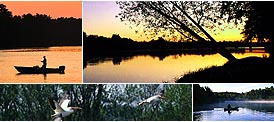
| Redfish | Sailfish | Sharks | Sheepshead | Snapper | Snook | Spanish Mackerel | Spotted Seatrout | Tarpon |

SNOOK
Regulations
Slot limit of not less than 24" or more than 34"; closed seasons are December 15-January 31 and June, July and August of each year; limit of 2 fish per person per day with one fish allowed to be greater 34"; snook permit required in addition to saltwater fishing license;
General Information
Snook may be the perfect gamefish. It is a tremendous fighter, requires skill to land and is one of the best eating fish you'll ever taste. Primarily inshore fish, snook don't travel the vast distance that other species are noted for. Most snook, often referred to as linesiders, spawn from April to October in the offshore waters near passes and inlets. The juvenile fish that survive those first few weeks of life in the open water eventually move into the estuaries where the fish most their lives. The fish can tolerate fresh water for extended periods of time and it is not unheard of for anglers fishing in fresh water areas that eventually connect to the coastal waters to catch snook when fishing for largemouth bass.
There are four species of snook but anglers don't need to worry about distinguishing one species from another. Three species, the fat snook, swordspine snook, and tarpon snook, never get larger than 18 inches so if caught, would have to be immediately released due to their size. Angler are after the common snook, a fish that can grow to the size of a small log and weigh over 30 pounds.
Distribution
Snook are warm water fish This limits their distribution to the waters south of Tampa Bay along the west coast and south of Cape Canaveral along the east coast. When the water temperatures drop below about 60 degrees, snook head for warmer waters. This is the reason for the December and January closed seasons. The fish become very lethargic when the water is cold and can easily be exploited by unethical anglers. At the northern range of the fish, some individuals die if they cannot find a warm water refuge. Snook are most commonly caught in protected waters and passes. They prefer to hang around overhanging mangroves, dock pilings, and any submerged structure. Some fish are caught in the nearshore waters over reefs and other structure.
Tackle and Techniques
A medium weight spinning or bait-casting rod and reel with 8 to 20 pound test line is a good idea. Snook are strong fighters. When fishing in areas where there is an abundance of cover, stick to tackle at the heavier end of this range. This fish is noted for its ability to run towards submerged structures and cut you off. It is also essential that you use a heavy monofilament leader, in the 40 to 80 pound range, to reduce break-offs caused by the fish cutting the line with their sharp gill covers.
Snook like to rest in an eddy and wait for the moving water to bring them food. For this reason, you will find anglers fishing for snook where the tidal flow is strong and there are eddies for the fish to use.
Bait
Snook will eat anything that looks good to them and is in range when they are hungry. Their favorite food is a small live fish, but live shrimp and small crabs are seldom turned down. Anglers should learn to use cast nets if they don't already know so that they can net their own bait. Usually you can freeline a bait fish and let it drift with the current. Occasionally a split shot is added to the line in areas where the current is especially strong.
Artificial lures are also popular baits for snook. Both soft and hard bodied lures shaped like baitfish, jigs tipped with shrimp and gold or silver spoons are traditional favorites. MirrOlures and Zara Spooks are two of the more popular brand names that you hear many when talking about catching snook. Ask at a local bait and tackle store which size, style and colors combination is working best at the moment.
When fishing for snook, cast your bait as close to the structure or shoreline as possible. Snook often will pass up a good looking meal if it doesn't pass right in front of its nose. Top snook anglers have good casting skills and can skip a bait underneath an overhanging mangrove branch without getting hung up.
Secrets to Success
* Fish at night for snook. Look for lights on docks and along seawalls that are close to the water. Snook will lurk in the shadows and dart out into the light when they see a meal swim by. Since small bait fish are attracted to the light and they are the snook's favorite meal your chances of finding snook around any light are pretty good.
* Anglers fishing from a seawall, dock or bridge that don't have a light, can dangle a Coleman lantern just above the water's surface. Once the light attracts the baitfish, the snook won't be far behind.
* When the water temperature drops into the 60s snook may move far up small tidal creeks and canals. Tolerant of freshwater they will move into these regions for brief periods. Look for them to be in the deepest holes you can find and hope they are hungry.












